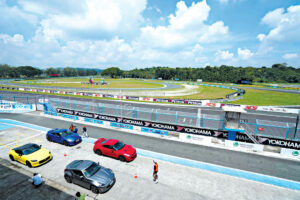By Dylan Afuang
WHEN ONE is pushing 200kph on the main straight of Clark International Speedway (CIS) — behind the wheel of no less than Nissan’s fastest and sharpest machines: the 370Z, Z, and versions of the GT-R — one begins to understand why these are so revered; why many a car enthusiast enshrine them in their halls of automotive heroes.
It’s easy for a regular driver to wax poetic on (and admittedly, even with racing instructors riding shotgun, feel like a driving god behind the tiller of) Nissan’s esteemed sports cars, with which Nissan Philippines, Inc. (NPI) once allowed the media and content creators to let loose — of course, as loose as safety measures and participants’ bravery permitted.
The automaker began creating its Z sports car line in 1970 — to enable drivers with casual driving and financial abilities to possess a relatively powerful rear-wheel-drive two-seater. Now on its seventh generation, the previous two iterations, the 370Z and its successor the Z, were marketed in the country by NPI from 2020 to 2023, and from 2023 to present, respectively.
In the Z, a twin-turbocharged three-liter V6 packing upwards of 400hp and 475Nm of torque resides up front, an upscale two-seater cabin sits in the middle, and two back wheels rein in the power with assistance from a nine-speed automatic. At P3.88 million, the Z isn’t affordable, but not as expensive as those shots of adrenaline from European marques.
Besides, even when less than half of its full potential is exploited, the Z already provides enough excitement. That 400hp V6 strongly yet progressively gives shove. Brakes sharply shed speed before corner entry, after which the car’s responsive handling and compact size enable the driver to enter and negotiate Clark’s hairpins and sweepers accurately.
Shortly after, it was time to be reminded why many consider the GT-R to be a supercar. From 1989, three iterations of the GT-R have transported four in both comfort and in blistering pace, using six-cylinder engines that send headline power figures to all four wheels. The current GT-R, tracing its origins from 2007, maintains its position in the auto world’s upper echelon.
NPI began retail of the R35 GT-R’s updated version last year. The most obvious changes are within the supercar’s front and rear ends, whose redesigns likewise boost the car’s downforce and stability. Coursed through a six-speed dual clutch, the 570hp and 637Nm produced by a 3.8-liter twin-turbo V6 are sent to all four wheels. All of these are in exchange of P12.45 million.
Cognizant to the car’s famed abilities and cool price tag, we gingerly lap CIS again — and yet never has 150kph appeared on the speedometer before our eyes so quickly. More than the GT-R’s amazing pace, it welcomes the track’s corners with strong brakes accompanied with responsive steering, and cornering balance that’s unfaltering, giving nary a body lean or pitch.
“These models represent the culmination of Nissan’s legacy of innovation, blending cutting-edge technology with the spirit of our iconic vehicles,” Nissan Philippines President Juan Manuel Hoyos said, adding, “Whether you’re seeking heart-pounding performance or a thrilling driving experience, these models deliver on every front.”
Indeed, witnessing the faultless performance of the Z sports car and GT-R grand tourer, one can validate their legendary status.
